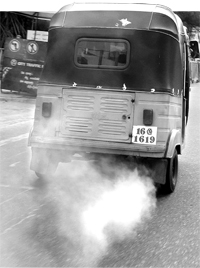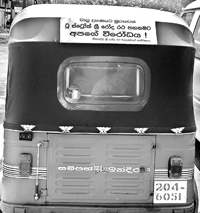
|
SMOKE ’EM OUT! Ask anyone in Colombo what the easiest way to travel around the city is and they will probably tell you –a three-wheeler, or trishaw. The little vehicle is perhaps the most popular mode of transport among most Sri Lankans – cheaper than a cab and often quicker because of its ability to weave through traffic. Still, there has been much concern over the years, regarding the pollution caused by three-wheelers. The recent decision taken by the Cabinet to ban the importation of two-stroke engined three-wheelers from 2008 while being welcomed by many as a positive move towards controlling air pollution, has also raised several questions among those who depend on these vehicles for a living, and as a means of transport.
Why has the Government chosen to impose this ban and how will it affect the general public? Decision to ban. The decision to make this move was made after the then Minister of Environment, Maithripala Sirisena and several other officials attended a conference in Yogyakarta Indonesia in December 2006 (BAQ 2006), regarding the improvement of air quality in Asian cities. After this conference they were convinced of the need to take more stringent measures to control air pollution in Sri Lanka. “Two-stroke engines have been banned in countries all over the world,” said the minister. “In Sri Lanka they have been recognised as a main cause of air pollution and for the increase in heart disease and respiratory diseases. We spend billions on healthcare annually. This decision has been taken in accordance with recommendations made by both local and international health organisations.” He further said that registration of two-stroke vehicles would continue up to mid 2008, and the ban on importation of spare-parts would only come into effect from 2011. There is to be no restriction on three-wheelers currently in use. The Central Environmental Authority (CEA) has been attempting to bring about such a ban for several years. “At the conference, we became aware that the BAJAJ Company in India was producing these two-stroke engined vehicles exclusively for Sri Lanka,” said Director, Environmental, Economics and Global Affairs, Ministry of Environment, Anura Jayatilake, adding that these engines have already been banned in cities in Asia.
Two-stroke Vs four-stroke engine three-wheelers Two-stroke engines are cheap and powerful and easy to maintain. However according to experts, compared to the four-stroke, the design of the two-stroke engine is such that it has low fuel economy, and higher emission of liquid Particulate Matter (PM) containing Hydrocarbons (HC) and volatile organic compounds. A two-stroke engine may emit up to 10 times as much as a four-stroke engine in terms of HC. It also gives a louder noise as compared to the four-stroke. Two-stroke engines moreover require the use of lubricant oil (SAE 30/SAE 40 or 2T) added directly to gasoline. Many three-wheel drivers use the wrong quantity and quality of this lubricant oil, further worsening the emissions from these vehicles. On January 12 – an average day in the city – data from the air quality monitoring unit in the Fort Railway Station, Colombo, showed the level of PM10 (microscopic particles that are detrimental to health) to be 84µg/m³ - about 4 times the WHO standard of 20 µg/m³. These emissions cause grave health effects to those exposed. Research by the Health Effects Institute of USA has shown that Particulate Matter which are fine droplets, liquid or solid emitted with the smoke - are extremely damaging to health as it goes deep in to the lungs as well as gets absorbed to the lung tissue and penetrates the blood. It can then cause Hypertension, Atherosclerosis, Heart Attacks, Strokes, Bronchial Asthma and Premature death of those exposed. The main victims of air pollution are schoolchildren, elderly people, pedestrians, public transport commuters and street vendors. The PM10 levels in Colombo have been estimated to cause each year: 3 million episodes of respiratory illness, 1000 cases of chronic bronchitis, 150 excess deaths and health damage equivalent to US$ 30 million. Manufacturers claim that oxidizing catalytic converters are used on recent versions of this engine, and can successfully burn up fuel-based pollutants. However, experts argue that this is only in principle, and that catalytic converters are only effective on new vehicles. A four-stroke three-wheeler costs approximately Rs. 15,000 more than a two-stroke one. Part of a roadmap towards better air quality “This is a very positive move towards better air quality in the country,” says Dr. Ruwan Wijayamuni, Environmental Health Specialist and Chairperson, CleanAir Sri Lanka. Ideally, he says, the ban should have included all two-stroke vehicles such as motorbikes and mopeds of which there are also a fairly large number in the city. Many studies have been conducted world-wide to prove the unsuitability of these vehicles he says, and countries with poorer economic growth than Sri Lanka, such as Nepal and Bangladesh have also banned them in their main cities. When two-stroke engined three-wheelers were banned in Dhaka in December 2002, there was an immediate measurable reduction in PM10 levels. India too has banned these engines in its cities including New Delhi. Countries such as the USA, Canada and Australia have even gone further to consider banning non-road two-stroke engines such as those found in lawn-mowers. “Safety limits are not targets to be achieved,” he says, stressing that even though Colombo’s air quality is reportedly better than that of cities such as Kolkota, New Delhi, and Jakarta, we shouldn’t have to wait until the emission levels have exceeded the safety limits to take action. “The ban is not an isolated incident; it is part of a governmental road-map for cleaner air in Sri Lanka.” Steps to implement the Vehicle Emission Testing Programme by the Department of Motor Traffic and the Ministry of Environment are also well underway, he adds. Dr. Wijayamuni feels that people will feel the positive effects of this ban in the long run, similar to the significant public health impact created by the introduction of unleaded gasoline in 2002. How will it affect three-wheeler drivers? Thirty four-year-old Weeratunga has been driving his two-stroke Bajaj three-wheeler for over ten years. It is the only source of income for the eight people in his family. “At first I was afraid that I would lose this vehicle too because of the ban,” he said. He is still concerned about the spare-parts ban in 2011. Explaining that in Sri Lanka a three-wheeler is sometimes used up to 20 years and spare parts are necessary for repairs, he says that the Government should provide alternatives. The majority of three-wheeler drivers share his concerns. The All Sri Lanka Three-Wheeler Drivers Welfare Association has protested the ban, saying that it would affect the lives of over 1.5 million people who depend on these vehicles. There are reported to be over 280,000 three-wheelers in the country, with an average of 40,000 being added annually. 99% of these are believed to be two-stroke three-wheelers. Nonetheless, the CEA says steps will be taken to ensure that the current three-wheeler users are not affected. The Government plans to grant concessions for the existing two-stroke three-wheelers to be converted to four-stroke. The CEA moreover hopes to hold awareness workshops for three-wheeler drivers regarding the benefits of four-stroke vehicles. Dr. Wijayamuni however, feels that the conversion from two-stroke to four-stroke may not be technically feasible due to the different sizes of the engines. A better alternative would be for current importers to begin manufacturing the spare-parts themselves, which would ensure the livelihood of those dependant on these as well as boost the national economy. This move has not been taken without consideration for the existing three-wheeler users, he adds. In many countries the ban extended to ‘in-use three-wheelers’ as well, and these vehicles had to be discarded in Katmandu, Nepal in 2001 and Lahore, Pakistan in 2006. |
|| Front
Page | News | Editorial | Columns | Sports | Plus | Financial
Times | International | Mirror | TV
Times | Funday
Times || |
| |
Copyright
2007 Wijeya
Newspapers Ltd.Colombo. Sri Lanka. |

